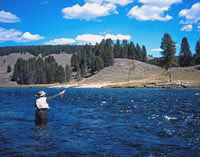Ed Marston, publisher of High Country News, proclaims in his paper’s April 10, 2000 issue: “The war between extractive interests and the environmental movement for control of the Interior West’s public lands is drawing to a close. The timber era, the cattle era, the mainstem big-dam era, the wise-use era are ending. An immense landscape is going from one set of uses to another set of uses, from one way of life to another, in an astoundingly short time.”

Trees are trendy in the New West.
Photo: USDA Forest Service.
He’s right. A conjunction of economic, cultural, and ecological forces have radically transformed Western politics.
From the Civil War until the first Earth Day in 1970, the West had a coherent politics, culture, and economy, glued together by the exploitation of its natural resources. But these resources have been high-graded. The richest ores, finest timber, and best dam sites have been exploited. The most beneficial opportunities are now largely exhausted. Further, the nation has become immensely wealthy. And with wealth and education comes heightened environmental sensitivity.
President Clinton’s proposal to set aside 40 million acres of national forest as roadless areas capitalizes on these changes. Although the initiative has been criticized as part of the administration’s “War on the West,” fiscal conservatives and the vast majority of Westerners could applaud the decision, even as they abhor both Clinton and the process.
Politicians who are tied to the traditional economy of the West claim Clinton’s initiative will eliminate jobs. However, roadless areas are undisturbed for a reason. Most of them have low economic value. Without implicit or explicit subsidies, resource extraction on these lands would be infeasible. Federal lands are political lands and heavy subsidies the norm. Therefore, the full costs of exploitation have been ignored, discounted, and obscured. Citizens of the New West demand better accounting of these costs.
The extractive sector no longer drives the Western economy. Ray Rasker, a Bozeman, Mont.-based economist with the Sonoran Institute, notes that since 1970, “Montana has added over 150,000 new jobs, and not one of the new net jobs has been in mining, oil and gas, farming, ranching, or the woods products industry.” The extractive industries are notoriously unstable, and commodity prices continue to cascade. The timber industry, for example, is leaving the West for the Southeast and foreign countries. Concurrently, technological improvements reduce the demand for labor.
Now, increased opportunities in the West are created by high-tech enterprises and services. The service sector includes professional occupations in law, health care, software, data processing, education, finance, and construction. Although they are not the traditional Western jobs, these occupations, like those in extractive industries, depend upon open space and natural resources. Why? Because professionals are increasingly footloose and are drawn to locations rich in environmental amenities. If well-managed — an uncertain prospect under federal ownership — roadless areas provide a base for a healthy economy in the New West.

A river runs through it — not a road.
Public comments to the Forest Service have overwhelmingly supported protecting roadless areas. Polls conducted by the Idaho Conservation League found that majorities across the West favor the roadless initiative. Even in Idaho, and even with the Clinton administration’s tag attached to it, 57 percent voiced support for the initiative. Without mention of Clinton, support jumped to 64 percent, a number in line with Idahoans who fish and hunt (65 percent), support conservative Sen. Larry Craig (R-Idaho) (66 percent), and favor George W. Bush two-to-one over Al Gore.
l use is driving for pleasure on the 83,900 miles of Forest Service roads maintained for passenger vehicles. Currently, the Forest Service has a backlog of $8.4 billion in road maintenance and reconstruction for its existing network. Yet, it receives only 20 percent of the funding it requires to fully maintain these roads. Restricting the construction of new r
The roadless proposal would also constrain other wasteful and destructive projects, including chaining of piñon pine/juniper, below-cost timber sales, and subsidized irrigation schemes.
Though few anticipated it, the West’s protected lands have become the region’s most important economic asset. Clinton’s initiative would protect the capital upon which the New West depends until the land is managed by responsible owners.


